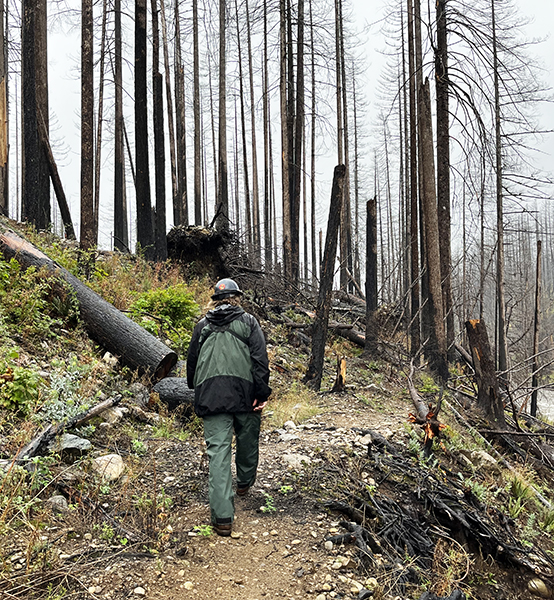Reporter for The Canyon Weekly
Efforts to rehabilitate and reopen the Little North Santiam trail in the North Fork area have received a strong boost.
The state’s Recreational Trails Program Advisory Committee rated the bid by the National Forest Foundation and the Willamette National Forest second on its list of recommendations at a Feb. 28-29 meeting in Salem.
Although there are several steps left before the money arrives and the two groups can begin work, the committee action almost assuredly means that the trail might reopen as early as spring/summer of 2025.
The trail, which provides access to some of the most popular attractions in the Opal Creek region, including the three pools area, has been closed since the 2020 Labor Day weekend wildfires.
The Little North Santiam trail runs along the south side of the Little North Santiam River, with its west trailhead off of Elkhorn Road SE and its east trailhead off of Forest Road 2207 near Shady Cove. Hikers can choose various lengths of trail to cover or shuttle between the two trailheads, which are roughly 4.5 miles apart.
Reopening the trail would be a big boon to those who like to hike and recreate in the Santiam Canyon, given that most Marion County parks, Bureau of Land Management and Forest Service recreation spots in the region remain closed.
The ten-person committee was charged with winnowing the list of grant requests of approximately $2.2 million to fit the $1.8 million budget the Oregon Parks and Recreation Department has available.
The program is conducted annually with approximately the same amount of money available each year. State and federal rules require that the grant funds assist both motorized and non-motorized projects.
Committee members at the Salem meeting showered praise on the Little North Santiam bid during deliberations on Feb. 29.
“It’s one of my favorite spots,” said committee member TJ Reilly. “It’s a high-use area, it’s a fantastic scenic area… I’m very impressed with this request.”
“I agree, it’s a great application,” said Philip Richardson, chair of the committee.”
The Little North Santiam project trailed only a Central Oregon mountain biking trail in the reviews of the ten committee members. The grant is for approximately $145,000 with a 20% match requirement, but the strong likelihood that the project will receive Great American Outdoors Act federal funding of about $40,000 will allow the state to shift that $40K to a trail project in Harrisburg that otherwise might have had to restructure its budget to match the lower grant amount.
The National Forest Foundation, which works regularly with the US Forest Service on projects, will use the grant funding to rebuild infrastructure on the trail, with three bridges the key items. The foundation, said Jeff Malik, the National Forest Foundation’s Oregon recreation projects coordinator, is hoping to use logs salvaged from the vicinity of the trail to build the bridges. Trail contractors hired by the Willamette National Forest will do the tread work on the trail.
“My hope is that a trail contractor can start work on the bridges and other structures this summer, with the goal of having the trail re-opened by the spring/summer of 2025,” said Malik. “I can give you a better timeline in a few months. It will be dependent on who bids on the construction and how many other jobs they have lined up already for the year.”
Willamette National Forest crews also will continue to work on the roads into the Little North Santiam, with officials hoping that the roads and trail will be ready for prime-time in a similar time frame.
“The National Forest Foundation is the congressionally chartered nonprofit to the Forest Service and we have been working in the state for many years,” Malik said. He has been meeting regularly with Matt Peterson, recreation programs manager with the Willamette National Forest and other Forest Service staff to identify which recreation projects they need additional capacity to help reopen.
Malik and Peterson addressed the committee via Zoom on Feb. 28, with Malik noting “there has already been a tremendous amount of work done by the ‘Salamanders’ volunteer trail crew from Cascade Volunteers to take care of some initial brushing and log-out. And we will be working with a youth corps program on final clean-up at the end of the project.
“A lot of these decisions about which groups are engaged with which project come down to the technical expertise and capacity of the various groups. The local volunteers are great at doing the work that they’ve already done. NFF has the expertise to find matching non-federal funds (such as these RTP grants), and the capacity to manage complex construction project contracts. Our contracting process can be quicker and cheaper than if the Forest Service was to do the work themselves. That’s the benefit that we bring to the table. The WNF staff do a great job of identifying their needs and then seeking out the most appropriate partner.”
The next step in the process, said Jodi Bellefeuille, OPRD trails program coordinator, is for the Oregon State Parks Commission to review and approve them at its April 24 meeting. The state will then forward approved project proposals to various agencies for further review. These groups include the Oregon Department of Transportation, the State Historic Preservation Office, environmental and cultural resources agencies and the Federal Highway Administration.
Notices to proceed with individual projects will come at the earliest in summer/fall 2024, Bellefeuille said.
The ten-person committee which reviewed the grant proposals includes non-voting members from the US Forest Service and the BLM. The remaining eight members all reflect recreational trails constituencies. There are two off-highway vehicle representatives, with the other six spots reserved for hiking, biking, equestrian, water trails, snowmobile and accessibility representatives. The USFS and BLM reps are selected by their agencies, with the OPRD director appointing the other eight. Committee members serve three-year terms and can serve up to six years.




